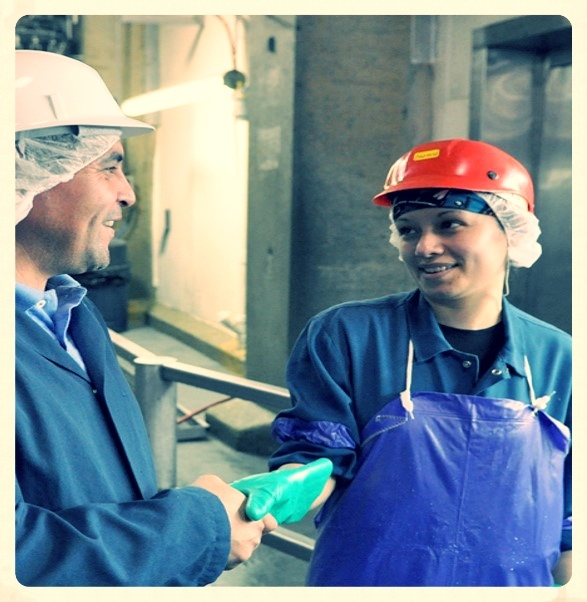Managing the High Cost of Turnover – Perspectives from 2015 NAMI Outlook Conference

I recently had the opportunity to spend time in our nation’s capital with many prominent leaders from the meat industry at the North American Meat Institute Outlook Conference. One area of focus for the conference was helping attendees understand the future of labor in the meat industry.
Did you know the average cost of turnover for a firm of 100 employees exceeds $400,000 per year?! Because of the impact, the Meat Institute welcomed us to share data from Alchemy’s Mind of the Food Worker Survey (#MOFWstudy). My presentation featured strategies that encompass employee total well-being using Maslow’s Hierarchy of Needs.

Photo: Wes Burke at NAMI Outlook 2015
From my days at Target, I can honestly say this approach significantly improves employee retention. Here’s how to apply Maslow’s Hierarchy of Needs to a retention strategy:
 |
 |
Maslow’s Hierarchy of Needs & Maslow’s Applied to Employee Satisfaction
Health & Safety (Physiological & Safety):
Health and safety is the most basic human need. Addressing this issue lays a solid foundation for employee satisfaction.
According to the Mind of the Food Worker study, 93% of employees feel empowered to stop working if and when they see a safety issue. This is great news for the industry because it indicates that the state of workplace safety is in good shape.

However, a big eye opener was the disparity between employees and supervisors, and their perception on coming to work sick. Only 18% of supervisors reported their employees’ work while sick, but over 50% of front-line food workers reported that they often come to work sick. An obvious area of concern with room for improvement.
Here are some strategies for improving overall employee health:
- Establish employee wellness programs
- Offer on site preventative care ie: flu shots, immunizations, chronic disease awareness
- Educate on the impact of working while sick, connect it to customer health
- Consider flexibility with sick leave policies
- Adjust perspective on health care costs: value of investment (VOI) compared to return on investment (ROI)
Career Progression (Belonging):
In the Mind of the Food Worker study over 76% of food workers reported a desire to move up or be promoted within their current company. Creating clear progression paths supports an employee’s need to feel a sense of belonging within your company, which in turn creates long term loyalty and dedication. Food companies may look to these employees to help address growing skill gaps within the industry, and look to internal resources to fill in demand leadership positions.
Over 67% of respondents said they’d like to be involved in the development of their training programs. Many of our clients include their employees in training content, including videos, not only increases the employee’s engagement, but also that of their peers.
By leveraging these willing employees it helps take pressure off trainers and creates a core team of in-house ‘experts’ who are willing to take ownership of driving your operations to the next level – and in turn your bottom line.
Some strategies for addressing financial and career needs:
- Create clear progression plans
- Offer employees opportunities to earn credentials
- Implement a rewards program for exemplary performance
- Explore opt-out 401K options to show your long-term commitment
Socialization (Esteem & Belonging):
A great takeaway from the Mind of the Food Worker showed that 82% of food workers felt they could go to their trainer or manager with questions or for advice. This shows that the majority of food workers trust their management to empower them with the tools needed to be effective at their jobs.
Some ideas for increasing socialization include:
- Gamified learning
- Badges and certifications
- Formal recognition ie: signage, newsletters, appreciation events
- Use of social media to connect and create forums for discussion
Quality of Life & Community (Self-Actualization):
Did you know, 61% of food workers consider their quality of life to be good? Food companies have the opportunity to reassure quality of life by promoting a sense of community and giving employees a chance to give back as well.
How to reinforce quality of life:
- Connect to a cause that employees care about
- Offer employee assistance programs
- Implement benefits and perks
- Keep an open door policy
- Entertain and value employees’ ideas
Final Thoughts
By meeting employees’ basic needs, food companies can show their team members they are truly an asset to the business. Taking this approach not only transforms the hourly worker into an empowered and engaged employee, but also builds a culture of happy, safe, and productive employees who will stay with you for years to come.
*Wes’ Note to the team:
The best part of my trip was definitely being to spend time with my fellow Alchemists. Terra, John, and Steve were awesome travel companions and make me realize how lucky I am to have such amazing co-workers that deeply care about clients and our company. I included a couple of pictures below. Yes, I even rolled out the white gloves!

Team Alchemy at NAMI Outlook 2015 (John Norton, Terra Brimberry, and Wes Burke) |

Setting the table for NAMI Outlook |







